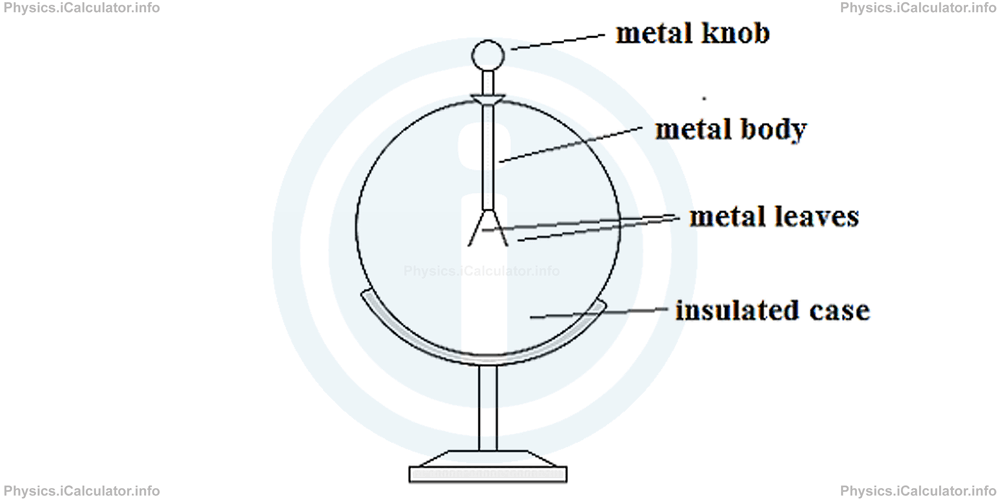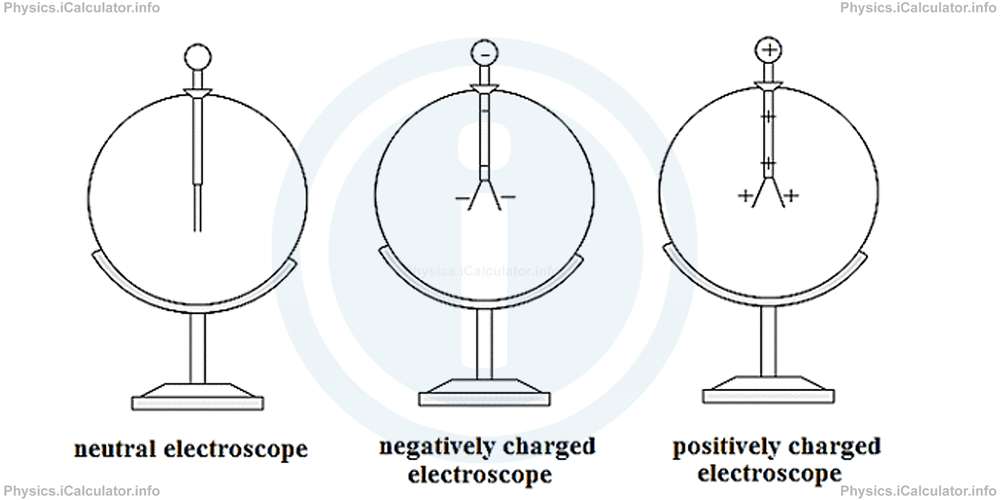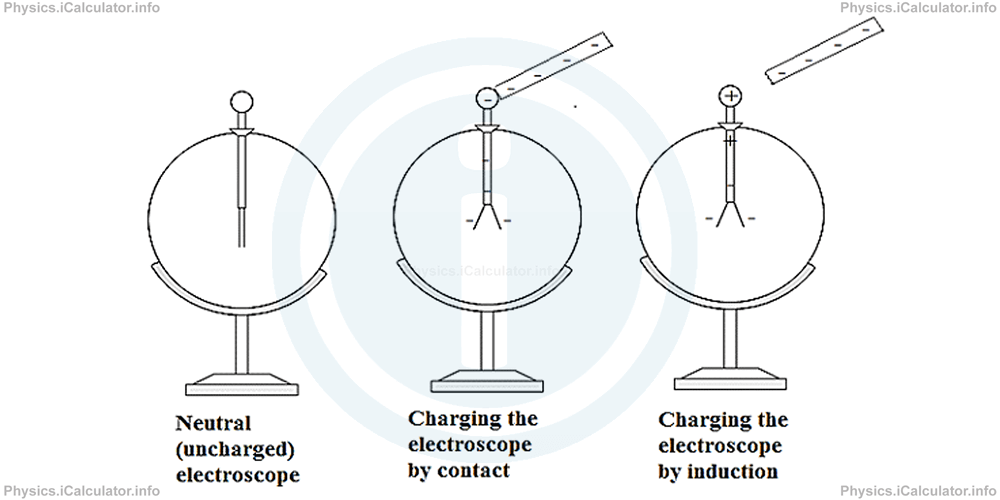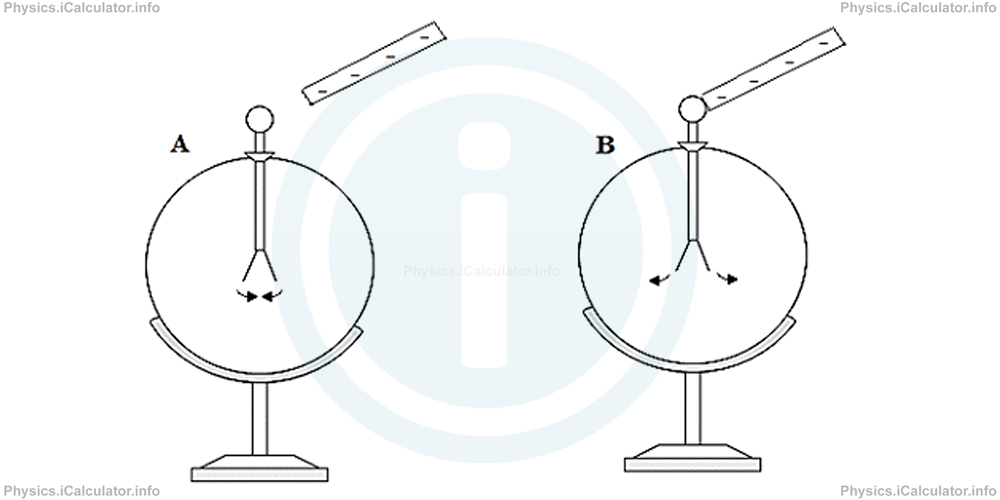Menu
Physics Lesson 14.1.7 - Electroscope
Please provide a rating, it takes seconds and helps us to keep this resource free for all to use
Welcome to our Physics lesson on Electroscope, this is the seventh lesson of our suite of physics lessons covering the topic of Electric Charges. Conductors and Insulators, you can find links to the other lessons within this tutorial and access additional physics learning resources below this lesson.
Electroscope
Electroscope is a device used to detect whether an object is electrically charged or not. It consists in a metal knob on the top, a metal body and two thin metal leaves attached to the end of the metal body. Leaves are kept inside an insulated case to prevent the interference of external factors such as air currents.

When an electroscope is neutral (not charged), its leaves always stay in vertical position due to the attraction of gravity. If the knob is electrically charged, the extra charges flow through all metal parts of the electroscope including the leaves. As a result, they open because the extra charge is of the same type everywhere and the leaves are very light to resist to the repulsion caused by the like charges accumulated in them.

Electroscope can be charged in two ways: by contact and by induction. If we touch the knob of an electroscope with a charged object, the leaves open. The extra charges then distribute throughout the metal parts including the leaves, which open as stated earlier. This is the method of charging the electroscope by contact.
On the other hand, when be bring a charged object near a neutral electroscope, the opposite charges are accumulated to the knob due to the electrostatic attraction, sending the like charges as far away as possible to the leaves (electrostatic repulsion). As a result, the leaves open as the electroscope is locally charged by opposite signs. This is the method of charging the electroscope by induction.

Example 2
The leaves of an electroscope A close when we bring a negatively charged object near its knob, while the leaves of another electroscope B open further when we touch its knob with the same negatively charged object. What were the original charges of electroscopes A and B?
Solution 2
The negatively charged object repels the negative charges of electroscope A from the knob to the leaves. Since the leaves close due to this action, it means they have been positive because the negative charges that have flowed to them have balanced the extra positive charges they previously had. Hence, the electroscope A has been positively charged prior to sending the object near its knob.
The negatively charged object sends electrons throughout the electroscope B by means of direct contact. Given that the leaves open more, it means the leaves become even more negative. This means the electroscope B has been negatively charged before the contact with the negative object.
You have reached the end of Physics lesson 14.1.7 Electroscope. There are 8 lessons in this physics tutorial covering Electric Charges. Conductors and Insulators, you can access all the lessons from this tutorial below.
More Electric Charges. Conductors and Insulators Lessons and Learning Resources
Whats next?
Enjoy the "Electroscope" physics lesson? People who liked the "Electric Charges. Conductors and Insulators lesson found the following resources useful:
- Electroscope Feedback. Helps other - Leave a rating for this electroscope (see below)
- Electrostatics Physics tutorial: Electric Charges. Conductors and Insulators. Read the Electric Charges. Conductors and Insulators physics tutorial and build your physics knowledge of Electrostatics
- Electrostatics Revision Notes: Electric Charges. Conductors and Insulators. Print the notes so you can revise the key points covered in the physics tutorial for Electric Charges. Conductors and Insulators
- Electrostatics Practice Questions: Electric Charges. Conductors and Insulators. Test and improve your knowledge of Electric Charges. Conductors and Insulators with example questins and answers
- Check your calculations for Electrostatics questions with our excellent Electrostatics calculators which contain full equations and calculations clearly displayed line by line. See the Electrostatics Calculators by iCalculator™ below.
- Continuing learning electrostatics - read our next physics tutorial: Coulomb's Law
Help others Learning Physics just like you
Please provide a rating, it takes seconds and helps us to keep this resource free for all to use
We hope you found this Physics lesson "Electric Charges. Conductors and Insulators" useful. If you did it would be great if you could spare the time to rate this physics lesson (simply click on the number of stars that match your assessment of this physics learning aide) and/or share on social media, this helps us identify popular tutorials and calculators and expand our free learning resources to support our users around the world have free access to expand their knowledge of physics and other disciplines.